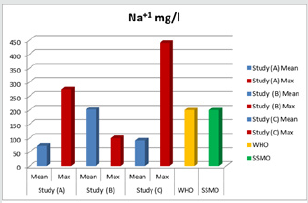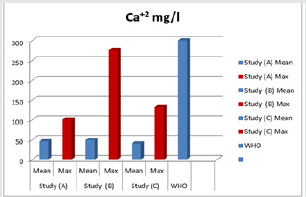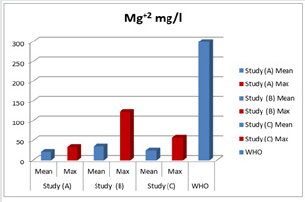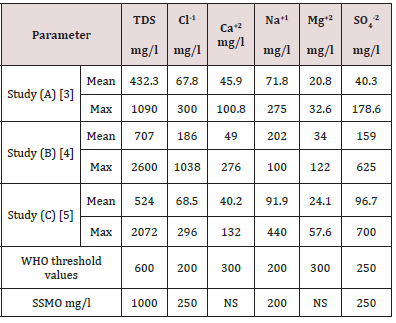
Lupine Publishers Group
Lupine Publishers
Menu
ISSN: 2641-6794
Research Article2641-6794 
Spatial and Temporal Variation of Groundwater Quality within Omdurman Locality Geological Zone Volume 3 - Issue 4
Ihab Hassan* and Safa Abdel Aziz
- Environmental Technology Department, Faculty of Environmental science, Omdurman Ahlia University, Khartoum, Sudan
Received: August 23, 2019; Published:September 10, 2019
Corresponding author: Ihab Hassan, Environmental Technology Department, Faculty of Environmental science, Omdurman Ahlia University, Khartoum, Sudan
DOI: 10.32474/OAJESS.2019.03.000169
Abstract
Groundwater is one of the main sources of water supply in many countries. Sudan has great potential of renewable and nonrenewable groundwater resources, which are important sources of water supply for domestic, industrial and agricultural uses. Omdurman locality is one of the biggest localities in Khartoum State, the capital of Sudan. The geological units in this area are composed of superficial deposits, volcanic rocks, Cretaceous sedimentary rocks and Basement Complex. Basement rocks representing the blanket upon which other formations were deposited, more or less subsurface occurrence to considerable depths. Groundwater quality may not remain unchanged, it undergoes temporal and spatial changes due to different reasons such as annual recharge, pollution and mass circulation. Quality may be changed to an extent that it may be unfit for the intended uses. This study aimed to assess the spatial and temporal variation of groundwater quality in Omdurman locality, Sudan in term of its physiochemical property.
A quantitative Comparative study was used for three previous studies carried out in the area during three sequential years 2012, 2013 and 2014. The mean and maximum concentrations of six parameters obtained in those three studies were compared. Although the study area of three previous studies has the same geological feature, great spatial variation and temporal fluctuation among the physiochemical characteristics were noticed. Some parameters showed gradual increase in concentration during three subsequent years,2012- 2014 such as sulfate while other parameters showed fluctuation during the same period such as sodium. Many parameters records levels of concentration exceeded both national and international standard levels. Routine check out of the physiochemical quality of the groundwater sources and investigating pollution sources among the borehole in the study area are highly recommended.
Keywords:Groundwater Quality; Physiochemical Property; Pollution
Introduction
Water is essential for all forms of life. Groundwater is one of the main sources of water supply in many countries. Exploration report by the Water Research Institute indicated that 90% and 25% of the rural and urban communities uses groundwater sources for their domestic use respectively. Chemical composition of water may be rendered unfit for human consumption, and thus may lead to health problems. The importance of groundwater quality in human health has recently attracted a great deal of interest [1]. Sudan has great potential of renewable and non-renewable groundwater resources which are important sources of water supply for domestic, industrial and agricultural uses [2]. Omdurman locality is one of the biggest localities in Khartoum State, the capital of Sudan. The geological units in this area are composed of superficial deposits, volcanic rocks, Cretaceous sedimentary rocks and Basement Complex [3]. Groundwater quality may not remain unchanged, it undergoes temporal and spatial changes due to different reasons such as annual recharge, pollution and mass circulation. Quality may be changed to an extent that it may be unfit for the intended uses. Many studies were carried out to investigate the chemical quality of groundwater at different location within Omdurman locality at different period.
Elkrail et al. [3] carried out a study to investigate the Hydrochemistry of groundwater at Omdurman area. Groundwater samples had been collected from 25 wells evenly distributed throughout the area where concentration of total dissolved solids (TDS), pH , electric conductivity (EC) and the major constituents ( Ca2+ , Na+ , Mg2+, K+ , HCO3-,CO3- SO42-, Cl-, NO3-) were determined. They found that Total dissolved solids (TDS) in the area varies from 130 to 1090 mg/l, calcium (Ca2+) ion varies from 11.2 to 100.8 mg/L, Sodium (Na+) concentration generally varies from 10 to 275.0 mg/L, Chloride (Cl-) ion concentration varies from 7.8 to 300.0 mg/L , Magnesium (Mg2+) ion varies from 11.0 to 32.64 mg/L, and Sulfate (SO42-) ion concentration in the study area varies from 3.0 to 178.6 mg/L [3].
Abdelmonem et al. [4] analyzed 92 groundwater well to assess the quality of drinking groundwater in Southern Suburb of the Omdurman City with respect to the total dissolved solids (TDS), fluoride (F-), total hardness (TH) and nitrate (NO3-). In addition, electric conductivity (EC), pH and the major cations (Ca+2, Mg+2, Na+ and K+) and anions (Cl- and HCO3-) were also investigated. They revealed that 27% of the wells having TDS levels in excess of the maximum recommended level of 1000 mg/l set by the Sudanese Standards & Metrology Organization (SSMO, 2002). With the exception of NO3-, some wells showed drinking water analyses in excess of the standards set by the SSMO [4]. A third study was carried out by Babiker et al. [5] to analyze Physicochemical of Surface and Ground Water in Karrary locality, Omdurman, Sudan. One water sample was collected from al gamair station and 11 samples from wells in the study area. Analysis was done using standard methods for temperature, pH, total dissolved solids (TDS), total alkalinity (TA), total hardness (TH), calcium, magnesium, chloride, iron, nitrate, nitrite, fluoride. The results expressed that some physicochemical parameters in the area were not satisfying the requirements in the World Health Organization [5]. This study aimed to assess the spatial and temporal variation of groundwater quality in Omdurman locality, Sudan in term of its physiochemical property.
Materials and Methods
To realize the objective of this study, a quantitative Comparative study was used for three previous studies carried out in the area during three sequential years 2012, 2013 and 2014. These studies investigated many physical and chemical parameters include TDS, Ca2+, Na+, Mg2+, SO42-, Cl-. The mean value and maximum value concentrations of each parameter were used for the comparison between the three studies.
Results and Discussion
Both mean and maximum values of sex different parameters of three previous studies were tabulated in Table 1 below along with WHO and Sudanese standards.
Total Dissolved Solid TDS
Both mean and maximum values of the first study (A) showed high values in TDS concentration that exceeded national and international values, Table 1 and Figure 1. In the next year the maximum concentration of TDS increased to nearly triple the value stated by local Sudanese Standards Metrological Organization (SSMO). During the third year the TDS concentration was still high but to some extent less than the previous year. This means that the TDS concentration in this area was increased each year and reached to a value that may possess health problem for those who consumed this groundwater for drinking purpose.
Figure 1: concentration of groundwater total dissolved solids TDS obtained from three previous studies A, B & C along with WHO and Sudanese standards.

Chloride
Figure 2: concentration of groundwater chloride obtained from three previous studies A, B & C along with WHO and Sudanese standards.

Most waters contain chloride caused either naturally by leaching process or due to human activities such as pollution from industrial and domestic wastes. Excess chloride concentration usually produces. As shown in Table 1 and Figure 2 the maximum chloride concentration values of the three studies were exceeding both national and international standard levels with a maximum value that reached to more than five times WHO permissible level in 2013. These values indicate an extreme variation in chloride concentration to an extent that makes noticeable taste in drinking water.
Sodium
Figure 3: concentration of groundwater sodium obtained from three previous studies A, B & C along with WHO and Sudanese standards.

The presence of sodium in water can affect persons suffering from heart, kidney, or circulatory ailments [6]. Table 1 and Figure 3 shows that sodium concentrations of ground water during three subsequent years varied widely with a maximum concentration greater than the WHO and Sudanese standards. This may lead to direct health risk among the consumers.
Sulfate
Figure 4: concentration of groundwater sulfate obtained from three previous studies A, B & C along with WHO and Sudanese standards

Waters containing high concentration of sulfate, caused by leaching of natural deposits, may be undesirable because of their laxative effects [6]. Table 1 and Figure 4 illustrate that both mean and maximum sulfate concentrations in Omdurman locality were gradually increased between 2012 and 2014 with only two values become greater than national and international permissible levels. However, this gradual increase may lead to objectionable concentration in the coming future.
Calcium and Magnesium
Figure 5: concentration of groundwater calcium obtained from three previous studies A, B & C along with WHO and Sudanese standards.

Figure 6: concentration of groundwater magnesium obtained from three previous studies A, B & C along with WHO and Sudanese standards.

Calcium and magnesium are among the major groundwater chemical constituent that can be from natural leaching process as well as industrial and wastewater disposal. Calcium and magnesium concentrations for the three studies showed reasonable level that below the international standards as shown in Table 1 and Figures 5 & 6.
Conclusion
The geological units in the study area are composed of superficial deposits, volcanic rocks, Cretaceous sedimentary rocks and Basement Complex. Basement rocks representing the blanket upon which other formations were deposited, more or less subsurface occurrence to considerable depths [4]. Although the study area of three previous studies has the same geological feature, great spatial variation and temporal fluctuation among the physiochemical characteristics were noticed. Some parameters showed gradual increase in concentration during three subsequent years,2012- 2014 such as sulfate while other parameters showed fluctuation during the same period such as sodium. Many parameters records levels of concentration exceeded both national and international standard levels. This can be attributed to water circulation and pollution sources within the area. Routine check out of the physiochemical quality of the groundwater sources and investigating pollution sources among the borehole in the study area are highly recommended.
Acknowledgements
I would like to Thanks Mr. Gasim Hassan for his financial support for publishing this article.
References
- Ardelshifa Mohammed, Elhassan Mohammed (2017) Chemical Contaminants in Drinking Water in Alshohada area Omdurman-Sudan. Asian Journal of Science and Technology 8(3): 4467-4475.
- Gamal Abdo, Abdin Salih (2012) Challenges facing groundwater management in Sudan. Global Advanced Research Journal of Physical and Applied Sciences (GARJPAS) 1(1): 1-11.
- Elkrail A, Hamid A, Obied B (2012) Hydrochemistry of groundwater at Omdurman area Khatoum state, Sudan. International Journal of Civil and Structural Engineering 2(4): 1051-1059.
- Abdelmonem M Abdellah, Hago M Abdel-Magid, Elhussein I Shommo (2013) Assessment of Groundwater Quality in Southern Suburb of the Omdurman City of Sudan. Greener Journal of Environmental Management and Public Safety 2(2): 83-90.
- Insaf S Babiker, Mohamed Abugaib, Mohamed A (2014) Groundwater quality assessment using GIS, the case of Omdurman area, central Sudan, Sudan Journal of Science.
- Davis ML (2011) Water and wastewater engineering. New York, USA: Mc Graw- Hill companies, pp. 2-24.

Top Editors
-

Mark E Smith
Bio chemistry
University of Texas Medical Branch, USA -

Lawrence A Presley
Department of Criminal Justice
Liberty University, USA -

Thomas W Miller
Department of Psychiatry
University of Kentucky, USA -

Gjumrakch Aliev
Department of Medicine
Gally International Biomedical Research & Consulting LLC, USA -

Christopher Bryant
Department of Urbanisation and Agricultural
Montreal university, USA -

Robert William Frare
Oral & Maxillofacial Pathology
New York University, USA -

Rudolph Modesto Navari
Gastroenterology and Hepatology
University of Alabama, UK -

Andrew Hague
Department of Medicine
Universities of Bradford, UK -

George Gregory Buttigieg
Maltese College of Obstetrics and Gynaecology, Europe -

Chen-Hsiung Yeh
Oncology
Circulogene Theranostics, England -
.png)
Emilio Bucio-Carrillo
Radiation Chemistry
National University of Mexico, USA -
.jpg)
Casey J Grenier
Analytical Chemistry
Wentworth Institute of Technology, USA -
Hany Atalah
Minimally Invasive Surgery
Mercer University school of Medicine, USA -

Abu-Hussein Muhamad
Pediatric Dentistry
University of Athens , Greece

The annual scholar awards from Lupine Publishers honor a selected number Read More...





